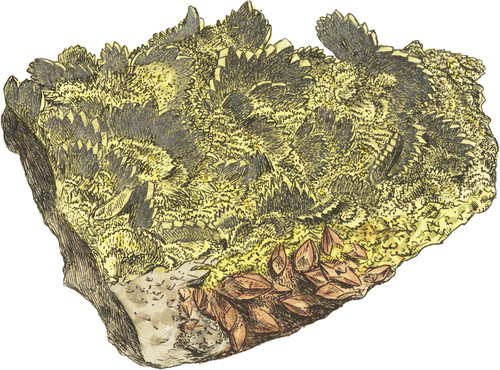 Enlarge
Enlarge
British Mineralogy
Cocscomb Pyrites
I believe this odd variety is peculiar to England, Kirwan (1st edit,) speaks of it as crystallized in small cubes or pyramids, united to a common basis “like cockscomb.” Dr. Babingtou and some others mention Cockscomb Pyrites, but some of our late mineralogical authors take no notice at all of it. It is said to be rare, excepting in Derbyshire; and as it is often very liable to decomposition, many cabinets that once possessed it are now without it. Mrs. Gent of Devizes was so good as to offer me the use of a finer specimen, that is to say, a specimen with larger cockscomb crystallizations. Both that and mine are probably in a state of slow decomposition, for they are dullish, and have a sulphureous scent, I suppose on account of the Sulphur passing from them. The smoother cubical pyrites and the striated have been considered by some as distinct species, because one is more apt to decompose and fall to pieces, as these and most others often do: this is therefore scarcely a sufficient distinguishing character; and I have most varieties in the changes by oxidizement, from the common brown to the red oxide, and I have British and Irish specimens in cubes, both smooth and striated, resembling those from the West Indies called Sargestum (about which I have have many inquirers); and I think, by various specimens which I possess of Oxidized Iron, that Pyrites under certain circumstances loses the Sulphur and becomes a solid red Oxide. The present specimen is on a gangue of Carbonate of Lime with some metastatic Crystals more or less stained or coloured by the red Oxides. Thus they change by degrees to distinct species at each extremity. This is perhaps a good example to show the difficulty of arrangement, and the infinite varieties; and that we should be cautious of indulging too much in little distinctions.

